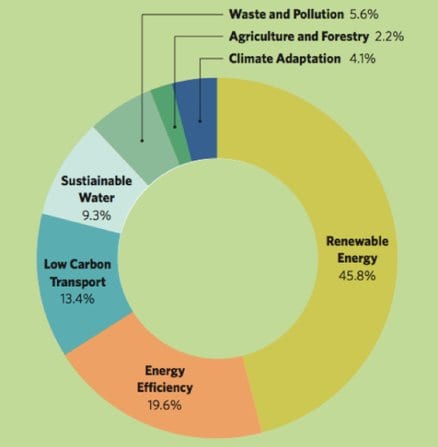
Achieving scale hasn’t been the only reason to celebrate the green bond market at the year-end; the real success is the geographical spread of green bonds across the world. Green bond markets are popping up all across the world, in Brazil, China, Estonia, Mexico and India… just to name a few!

Green bond market momentum continues to build after a successful COP in Paris.
Now we did push hard in 2015 to get $100bn issuance of green bonds out over the year; although the market has not yet hit our ambitious target, there is no doubt that green “shoots” of green bond markets are spreading far and wide. This was ever present at the Paris COP in December 2015 where green bonds were highlighted as a key tool in many of the Climate Finance side-events.
Check out our COP blog for more details.
2015 saw a wider range of issuers and types of green projects or assets.

Similar to 2014, the entry of more corporates, banks, and municipalities into the green bond market bolstered growth in 2015. There was also a widening of the type of projects financed by green bonds with more proceeds leveraged for other green sectors outside of the renewable energy space, in particular low carbon transport and sustainable water.
Policy support is catalysing green bonds, especially in emerging markets as India and China start rolling out green development plans and green finance policies to support them.
Building up to and post COP21, strong political commitment to grow local green bond markets has driven the global green bond market towards increasing involvement in emerging markets. In 2015, China and India have both had inaugural green bond issuances, and considered policy support. China published official green bond guidelines in December, and India have also started developing official guidelines.
- India led with an inaugural green bond from Yes Bank, (INR 1000 crore, AA+, 10 yrs), followed by Export-Import Bank of India ($500m, BBB-, 5 yrs); CLP Wind Farms (INR 6bn, AA, 3-5yr), and lastly IDBI ($350m, BBB-, 5 yrs).
- China wasn’t far behind with its first corporate green bond (issued offshore in Hong Kong) from Goldwind ($300m, 3 yrs). Agricultural Bank of China then issued the first finance sector green bond in three tranches RMB600m, $400m, and $500m (A, 2-5 yrs).
Greater disclosure on green project selection, proceeds management and environmental impacts shows increased transparency in green bonds. The US green bond market has been relatively slow to adopt the independent review model prevalent in other green bond markets (with the exception of DC Water, which got a Vigeo second review). Instead US issuers tend to use proxies such a green building certification to identify green projects, for example leveraging LEED to identify low carbon buildings.
However, this year there was a small shift towards the independent review model Europe uses, with Morgan Stanley providing a review for its inaugural green bond ($500m, BBB+), followed by Renovate America ($201.5m, AA) and U.S. municipal bonds (Central Puget Sound Transit ($942.8m, AAA, 3-35 yrs); DC Water ($100m, AA, 3-12 yrs)). We expect this trend to continue in 2016.
A growing number of green bonds are aligned with or certified against the Climate Bond Standard. Certified green bonds have been issued by Mexico’s Nacional Financiera ($500m, BBB, 5 yrs); ABN AMRO (€500m, A, 5 yrs); ANZ (AUD600m, AA-, 5 yrs) and NAB ($300m, AA-, 7 yrs); and a number of smaller retail bonds from BELECTRIC in the UK. Certification provides assurance that proceeds are used for assets aligned with a low carbon and climate resilient economy.
Investor interest in green bond outstrips the supply
Growing investor demand, particularly by institutional investors and corporate treasuries, continues to result in over subscriptions as well as pledges to invest billions more capital into green bonds.
2015 commitments to invest in green bonds include: EUR 1bn by ACTIAM, EUR 1bn by Deutsche Bank, $1bn by HSBC, £2bn by Barclay s, $2bn by Zurich Insurance and EUR 1bn by KfW
Further to these commitments, specific green bond mandates or funds are being managed by AXA, SEB Investment Management, State Street, BlackRock, Calvert Investments, Nikko Asset Management and Shelton Capital Management.
In December 2015, at the Paris COP, asset owners, investment managers and individual funds managing $11.2trn of assets signed a statement in support of the green bond market.
The rising tide of reporting on green bonds

Importance of reporting
Reporting is key to validating the green credentials of the bonds. Investors need to know what their green bond holdings are financing. The Climate Bonds Initiative will dive further into reporting on trends and market states in 2016.
There has been increasing interests and efforts in green bond reporting
We have seen higher quality reporting (e.g. EIB Climate Awareness Bonds broke down proceeds allocation by bonds and projects). There have also been strong trends in establishing outcome KPIs, disclosing reporting framework, and committing to third-party assurance on reporting.
Majority of issued green bonds provide annual reports
Half of outstanding green bonds were issued more than a year ago therefore should have reported. The majority of them have disclosed their annual reports. Over 90% of the reports disclosed proceeds allocation and climate impacts of projects or assets financed.
Growing awareness in the market
In addition to the update of the Green Bond Principles wording on reporting, several development banks jointly drafted a framework on Green Bond impact reporting harmonization.
Looking towards 2016, we anticipate that the green bond market will diversify in financial products, with potentially the first sovereign green bond and green sukuk in the pipeline. Certified bonds are also expected to grow in the coming year, along with more forestry bonds.
Read the full 2015 year end report here.







